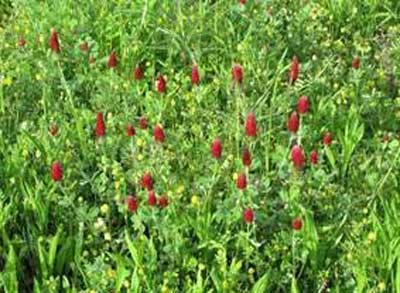
Cover crop selection should be based on both goals and cash crop rotations. In the previous article (Cover Crop Considerations, August 11) ten primary benefits of cover crops were summarized.
- reducing soil erosion and nutrient loss,
- scavenging and temporarily holding excess nutrients,
- improvement of soil condition,
- suppression of weed growth or pests,
- providing nitrogen for the following cash crop
- diversifying the crop rotation and breaking disease cycles
Cover crops frequently will meet one or more of these goals. Growers should consider what their primary goals will be for the cover crop on a field-by-field basis.
Grasses
- Pros – Grasses are generally good at protecting soils, scavenging and holding nutrients, and improving soil condition with penetration of fibrous roots into the soil. Some, like annual (Italian) ryegrass, will help suppress weed growth. (Note cautions with use of annual ryegrass.) Grasses are typically good companion covers with legumes or brassicas, like radishes. Grasses also generally contribute large amounts of mulch to help protect the soil in no-till systems. Cereal rye tolerates late seeding.
- Cons – For all its benefits, annual ryegrass can turn into a very competitive weed, itself, and many populations are glyphosate resistant. Though grasses are usually good at scavenging nutrients, depending on when they are "terminated" in the spring, they can also be slow to give the nutrients back to the next crop. Small grain cover crops may actually host certain pest insects.
Legumes
- Pros – Legumes are noted for having roots that penetrate deep into the soil (if established early enough and allowed to grow long enough). Most species of legumes, used as cover crops, will contribute nitrogen for the next cash crop. With a lower carbon-nitrogen ratio, the residue or mulch from legumes usually breaks down and releases nutrients more quickly than the mulch from grasses.
- Cons – With the exception of crimson clover, many legumes are slow to establish in the fall and need to be seeded into the standing cash crop in order to promote adequate fall growth. (Clovers have traditionally been established into, or following, winter wheat or other small grain crops with good success.) Some legumes, like hairy vetch, can be competitive and difficult to terminate in the spring.
Brassicas
- Pros – In our area, when we speak of brassicas, we are normally talking about daikon radishes, also known as oilseed radishes or tillage radishes, although turnips, rapeseed, and canola are also in this group. Tillage radishes establish rapidly in the fall and produce a large taproot that penetrates through soil hardpans. Radishes are good companions with grass species, help scavenge excess nutrients and readily winter kill. When the radishes die, they leave open channels into the soil and easily release the nutrients they've taken up. As a group, brassicas are known to suppress nematode populations, although this varies.
- Cons – When radishes winter kill and decay, they stink. Growers should consider where radishes are grown so that they do not offend neighbors or themselves. Some soil experts are concerned that the channels, left in the soil where radishes are grown, may inadvertently serve as direct conduits for nutrients into water that leaves the field.
Common Cover Crops (not an exhaustive list.)
- Oats and Radishes – This combination establishes rapidly in the fall and normally winter kills, saving the grower the cost and trouble of terminating the crop in the spring. This combination does not contribute as much mulch as other cover crops, which could be either a positive or negative feature, depending on goals.
- Cereal Rye and Radishes – This combination is best when direct seeded but some have had luck broadcasting the seed into standing crops. The combination usually establishes fairly rapidly in the fall. Timely spring termination is necessary or the rye will produce excessive growth that does not break down well.
- Oats and Crimson Clover – This combination establishes rapidly. The oats winter kill and the clover may partially winter kill as well. The combination scavenges excess nutrients fairly well and the crimson clover will contribute varying amounts of nitrogen, depending on when it is planted and how much growth occurs prior to cold weather and before spring termination.
- Crimson Clover and Radishes – Establishes fairly rapidly, scavenges nutrients, contributes nitrogen to the next crop, and residue breaks down rapidly.
- Annual (Italian) Ryegrass and Radishes, or Annual Ryegrass and Crimson Clover – Establishes and covers well. Excellent for scavenging nutrients and producing limited amounts of nitrogen. CAUTION: FOR EXPERTS, ONLY! Annual ryegrass can be very difficult to manage.
- Austrian Winter Peas and Radishes – Austrian winter peas are getting a second look after fading from popularity a few years ago.
Cover crops can be as simple or as complicated as you like. Remember to keep goals in mind when considering the cover crop decision. The Midwest Cover Crops Council (and other groups) have provided a cover crop decision tool which can be found here: http://mcccdev.anr.msu.edu/covercroptool.php
Contact your FS Member Company for advice on cover crops.